Hwange NP is the largest national park in all of Zimbabwe. It has approximately 14,600 square meters. Declared a national park a few years ago, in 1961, it previously served as a hunting ground for the royal family.
It has different habitats where a wide variety of birds (400 species) and mammals (100 species) live, and has the greatest diversity of all the parks in the country. But what has really made this park famous is its large concentration of elephants, which reaches about 50,000 specimens. The largest concentration in the world.
Despite the importance of elephants, the Hwange NP is also known for being able to see lions, leopards, cheetahs and wild dogs. So, if you are visiting Zimbabwe this park is a must stop and it is very close to Victoria Falls, one of the other must-sees in the country. If you want to know more about our experience, you can click here.
The fight against drought as a goal to maintain wildlife
The western part of Zimbabwe has experienced several episodes of drought that have had serious consequences for its inhabitants and their animals. As early as 1920, when the park was still a reserve, many animals did not find water inside the park during the dry season, so they went outside to look for water. This fact increased the encounters between humans and wildlife, which did not always end well. To protect wildlife, windmills began to be installed to pump water into waterholes that were dry during the dry season. Today, you can still see some of the mills from that time.
Today, most of these water pumps are solar or hybrid (solar and diesel) and continue to be used to keep the waterholes full and the animals can go there to drink. In addition, they can also be used by communities living east of the park so that they do not have to go that far to find water.
Therefore, we consider it very positive that this park can be kept alive thanks to these water pumps, because otherwise the Hwange would surely become a desert place with a very shocking drought throughout the territory.
How to get there?
By air, there is the possibility of arriving by plane to Victoria Falls and then take a private transport (where you will have to haggle the price) that will take you to the Hwange Main Camp which is the most accessible camp. Private campsites also offer a shuttle service for their guests.
By road, it is only an hour’s drive from Victoria Falls on a well-paved and paved road. The park has two entrances that are closest to Victoria Falls: the West entrance (near Robins camp) and the Hwange entrance to the north (near Hwange Main Camp).
To get to the west entrance, you have to take the turnoff that you will find on the main road (A8) and which is the one closest to the town of Victoria Falls (47 km on the right). Then you will have to drive for 55km on a dirt road where you can already see some animals along the way. You can only check in at the front door and then go to Robins Camp to pay for the tickets.
To get to the North Hwange entrance, take the A8 main road until you reach the town of Cross Mabale. There you will have to deviate and drive about 25 km on paved road until you reach Hwange Main Camp.
Permits and prices
Permits to enter the park costs $ 20 per person and if you also want to enter with your car, you will have to pay a $ 10 permit. These prices are only if you enter and leave the park on the same day.
However, if you spend the night in the park, admission per person is reduced to $ 10 and is valid until the next day at 6 p.m. A whole bargain, right? Think that in most parks the ticket is valid for only 24 hours, but here in Zimbabwe if you enter on Monday at 9am and pay for a day, you will have until Tuesday at 6pm to stay inside the park.
To sleep, you have different accommodation options that you also have to pay for once you arrive at the front door. These range from $ 23 to $ 29 depending on the type of campsite and the location you want to choose.
As for payment, we paid by credit card (N26) and we accepted it. However, the ranger told us that we were lucky because the machine often does not accept foreign cards, and the only way to pay is in cash, that is, in dollars.
What to do in Hwange NP?
– Do a car safari through the park
This is the best way to get around and get to know the park. It can be done with your own car (as we did) or hired to do a game drive from the camp where you are staying. Usually in the early hours of the morning, when the sun rises, it is the best time to see animals and also in the evening before sunset.
The park has many different areas and many platforms or viewpoints in front of the different waterholes, where you can park and have a good time watching the animals around you from the viewpoints.It’s a different experience since in most parks, you can’t get out of the car. The day passed very fast!
We recommend the following areas that we really liked in order from west to east that we did:
- Big Tom and Little Tom: area where many cats can be seen near Robins field. We weren’t lucky but we found people the same day they saw them.
- Mandavu Dam and Deteema Dam: Viewpoints where many animals can be seen drinking in the waterhole on the way to Sinamantella Camp.
- Masuma Dam: We saw a lot of animals. We had lunch at the lookout while watching the animals coming and going. A whole show!
- Guvalava Pan: Here we slept. Read the experience we had after in this article, we’re still in shock!
- Nyamandhlovu Pan: One of the most famous for the big quantity of animals you can see there, near Hwange Main Camp.
- Makwa Pan and Balla Pan: These two pans are also close to Hwange Main Camp. Lions can also be seen there.
- Kennedy Pan: famous for its elephants.
– Sleep in a wild area on a platform or picnic place
In the section “Where to sleep in the Hwange NP?” you will find the different camps in the picnic areas of the park where you can sleep and live a totally wild experience with direct contact with nature. We camped at the Guvalava Platform and in the evening, when the sun went down, zebras, impalas, hyenas began to arrive … to drink water from the waterhole we had in front of the car.
And the amazing thing is that late at night, with the full moon illuminating the pond, herds of elephants were passing around our car. Maybe there were more than 200 elephants at some point!! Amazing!!
– Visit the Painted Dog Conservation Centre
This organization is doing a great job of conserving wild dogs and educating the communities in the area. These very special animals are in danger of extinction due to habitat loss, hunting, car slaughter, etc. It is estimated that there are about 700 specimens in the Hwange area. You can read more about this fantastic animal by clicking here.
The center works with anti-hunting units, a rehabilitation area to reintroduce injured or sick wild dogs, group monitoring, community education and schools …
You can take a tour of the room in the center where they have different information about these animals through the true story of one of them. A worker from the center will tell you more about these beautiful animals and you will also be able to visit the rehabilitation center to find out about their work and see some of them who are interned there. The visit is free but donations and / or purchases are accepted in their shop where sculptures are made with the materials of the traps they find. You can check out their website here.
– Do a walking safari in Hwange NP
From the different camps where you stay you can book a safari walking through the park. You can usually see elephants, impalas, waterbucks … and sometimes if you’re lucky, some felines. You will be accompanied by a guide and ranger. Groups must be smaller than 8 people.
Where to sleep in Hwange NP?
There are three fixed camps within the park where you can sleep in cabins / bungalows or camp on their land. These are:
– Hwange Main Camp: It is the main and largest camp. It is also the most accessible if you do not have your own transport because it is close to the main road. In the area, the Nyamandhlovu Pan or the Kennedy Pan stand out, famous for seeing a large number of animals, including many elephants. Camping costs about 17 USD per night.
– Sinamatella Camp: It is located in the middle of the park, 125 km from the Main Camp. Many people recommended it to us because at night, there is a lot of animal life around and you can hear the roars of lions and hyenas. The price of the campsite is 17 USD per night.
– Robins Camp: Located further west, 60 km from Sinamatella. They recommend it mainly because it is close to Big Tom and Little Tom, famous loops where you can see the lions if you are lucky. The price of the campsite is about 20 USD per night.
Apart from these fixed campsites, there is the possibility of staying overnight in a picnic area of the park where there are viewpoints and / or platforms to see the animals in front of a waterhole. This is the choice we made and we totally recommend.
The price of the campsite ranges from about 23-29 USD depending on the place you choose to camp. Highly recommended are the following viewpoints: Masuma Dam, Mandovu Dam or Deteema which have a water point and toilet. Also, there is the Guvalava Platform that does not have these facilities and you have to bring everything with yourself. We chose this one.
Our route
DAY 1: In the morning, after searching for our PCR results in Livingstone (Zambia), we took the opportunity to cross the border at Victoria Falls, one of the easiest and fastest borders we have crossed in our journey through the African continent. Since we had already visited Victoria Falls before the pandemic, we stopped only at the town to exchange money (we carried dollars in big notes and we were advised to go with small notes. The issue of currency in Zimbabwe is very curious and if you want to know more, you can click here) and to buy a SIM card for your phone.
After doing these errands, we had lunch and drove up to about 20 km from the west entrance where we camped free as the day went on. It was our first night of many free camping trips in the country, where we met a herd of cows and were able to rest until the next day to visit one of the most beautiful parks in the country, the Hwange.
DAY 2: We got up early and drove to the door where our vehicle details were taken and continued on to Robins Camp to pay our entrance and camping fees inside the park. In Zimbabwe, entry is not 24 hours but is valid until the next day at 6pm when you have to leave the park. Therefore, they give you more time to enjoy your safari inside the park. In addition, the ranger told us that they had seen cheetahs and lions in the Big Tom and Little Tom area; so we approached there but were unlucky enough to find them. Along the way we found large herds of elephants, the star animal of the park.
After going through the two Toms, we continued our route stopping at different viewpoints and waterholes we found along the way. Just after Deteema Dam, we found a group of antelopes, zebras, and two giraffes perched in the shade of a tree. It was hot that day so we drove up to take some beautiful pictures from that moment.
We stopped for lunch at Mandavu Dam, where we were at the lookout with elephants in the water; and we continued to arrive before it got dark at Guvalava Platform, our place where we would spend the night. This platform is a free campsite located right in front of a waterhole and many animals are said to go there. But when we got there, we only saw birds.
After setting up the rooftent while waiting for the animals to arrive, we saw a group of warthogs approaching the water and; suddenly, on the horizon, three hyenas approached to drink water. Really, we had them very close and we could see how they played and fought among themselves; and we could also hear them with their characteristic howl. We dined on the lookout at sunset to protect ourselves from the animals as we watched small groups of elephants approach the water, dive in, and continue on their way. Anyway, the movie about elephants had just started!
When we were inside the rooftent of our car, we started to see and hear large herds of elephants running next to our car and stopping at the waterhole to cool off. Luckily, that day was a full moon so from the tent we could see all this spectacle, with herds crossing and facing each other, elephants passing right next to us and looking at us but luckily they kept walking (and we were motionless almost out of breath) and all the noises and sounds of water that made us feel really surrounded by wildlife that night and made us close our eyes very little!
DAY 3: We woke up in the morning and there was no one left in the pool. We were having breakfast on the platform when a group of hyenas reappeared on our left, coming to drink water. We waited for them to leave so we could pick up and follow our route through the Hwange NP.
We turned off the main road to the Main Camp for a circular route and reached the Kennedy Pan, famous for its elephants. There we found large herds crossing the road, some in the shade cooling off, others eating from the trees… Really, we thought it was almost impossible to get into the Hwange NP and not see any elephants! We continued our journey to the Main Camp, where we stopped for lunch at the Makwa Pan that the guides have told us that they have seen lions in the morning (we were not lucky, it was too hot, but we saw a group of giraffes who were drinking water), and then we arrived at the Main Camp on the other side of the park.
From there we took the opportunity to visit the Nyamandhlovu Pan, one of the most famous waterholes in the park, but when we went there it was very empty (this shows that the animals live in complete freedom); and we did a couple of laps around the Balla Balla Pan where we had been told that the lions were there that day. Unfortunately, we didn’t see them either.
We left Hwange NP surprised by the number of elephants living there, and the night we spent in Guvalava Pan where we slept nest to large herds of elephants. We were not lucky enough to see lions and, above all, to see wild dogs, one of the most difficult animals to find but the most beautiful to see.
We had to keep all these days in our retina doing free camping just outside the park. Next day we had to cross the country for two days through a mountainous area and look for another of the most impressive parks in Zimbabwe: the Mana Pools NP.
































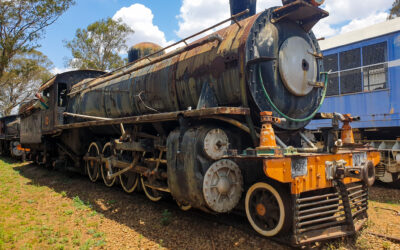
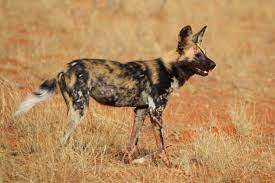
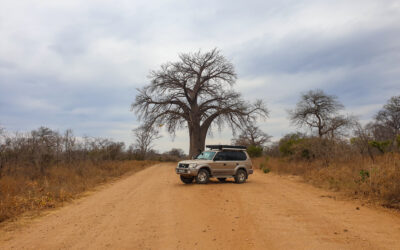


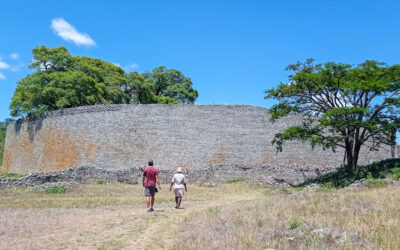
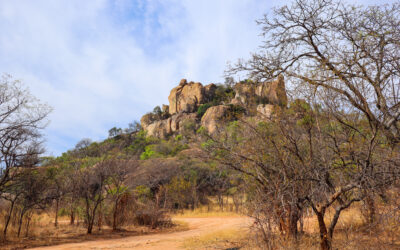

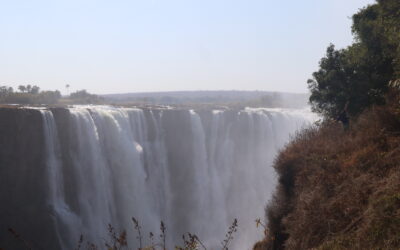
0 Comments